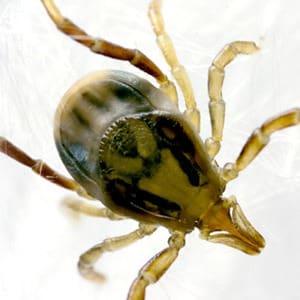Bacteria from the same group as the organism that causes Lyme disease, (the Borrelia group), have been discovered in an Australian paralysis tick (scientific name Ixodes holocyclus).
But researcher Dr Peter Irwin, Associate Professor in Small Animal Medicine at Murdoch University, is quick to say that the Lyme disease bacterium itself has not been found in an Australian tick.
Lyme disease is caused by Borrelia burgdorferi. We found them in German ticks. We didn’t find them in Australian ones, ” says Dr Irwin, leader of the study that made the discovery.
The researchers sequenced DNA from 196 paralysis ticks collected in NSW between 2004 and 2012 and compared the results with 30 German ticks of a different species, Ixodes ricinus. Lyme disease is known to exist in German ticks.
“We found this different Borrelia in one Australian tick. And I think we need to emphasise – it is only one tick. Maybe it was a one-off and we’ll never find it again … or maybe it’s quite widespread,” says Dr Irwin.
The DNA sequence was too short to determine whether the Australian Borrelia was one of the 4 species causing relapsing fever or a new, very closely related species, says Dr Irwin.
The finding is the first report of a relapsing fever Borrelia species in Australia, which “may have public health implications,” the authors write.
There is a vigorous debate about the possibility of a tick-borne Lyme-like disease existing in Australia, which was the subject of a Clinical Advisory Committee set up by the Chief Medical Officer, Dr Chris Baggoley, that was dissolved in July 2014.
A new species of bacteria in the Candidatus Neoehrlichia genus was also detected in the Australian ticks. A closely-related species (Candidatus N. mikurensis) can cause serious illness in people who are immuno-compromised, the authors write. It is the first time this genus has been detected in Australian ticks.
Candidatus Neoehrlichia was found in 16 of the 196 Australian ticks, with 3 of these ticks being removed from people.
Dr Irwin says the next step is to test more ticks using his new technique. He has plenty in waiting, including ticks removed from Australians who believe they have a Lyme-like illness.
Claire Pain





